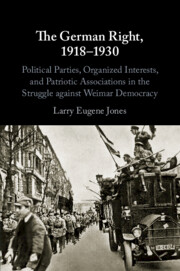 The German Right, 1918–1930
The German Right, 1918–1930 Book contents
- The German Right, 1918–1930
- The German Right, 1918–1930
- Copyright page
- Dedication
- Contents
- Figures
- Acknowledgments
- Abbreviations
- Introduction
- 1 Revolution and Realignment
- 2 Infrastructure of the German Right
- 3 Forging a Conservative Synthesis
- 4 Growth and Consolidation
- 5 The Radical Right
- 6 1923 – A Missed Opportunity?
- 7 From Triumph to Schism
- 8 Stabilization from the Right?
- 9 Paladins of the Right
- 10 A Resurgent Nationalism
- 11 The Road Back to Power
- 12 The Burden of Responsibility
- 13 From Defeat to Crisis
- 14 Reverberations and Realignment
- 15 The Chimera of Right-Wing Unity
- 16 Schism and Fragmentation
- 17 The Brüning Gambit
- 18 The September Earthquake
- Epilogue
- Select Bibliography
- Index
14 - Reverberations and Realignment
Published online by Cambridge University Press: 21 March 2020
- The German Right, 1918–1930
- The German Right, 1918–1930
- Copyright page
- Dedication
- Contents
- Figures
- Acknowledgments
- Abbreviations
- Introduction
- 1 Revolution and Realignment
- 2 Infrastructure of the German Right
- 3 Forging a Conservative Synthesis
- 4 Growth and Consolidation
- 5 The Radical Right
- 6 1923 – A Missed Opportunity?
- 7 From Triumph to Schism
- 8 Stabilization from the Right?
- 9 Paladins of the Right
- 10 A Resurgent Nationalism
- 11 The Road Back to Power
- 12 The Burden of Responsibility
- 13 From Defeat to Crisis
- 14 Reverberations and Realignment
- 15 The Chimera of Right-Wing Unity
- 16 Schism and Fragmentation
- 17 The Brüning Gambit
- 18 The September Earthquake
- Epilogue
- Select Bibliography
- Index
Summary
Chapter 14 explores the reverberations of Hugenberg’s election and the realignment of political forces that it set in motion. It begins with a discussion of the situation in the DVP, where Stresemann found himself forced on the defensive by the increased assertiveness of the industrial interests on the party’s right bring and where the Stahlhelm’s “hate declaration” against the Weimar Republic led to a rupture of its relationship with the DVP. The chapter then switches to the Center, where an effort to block Stegerwald’s election to the party chairmanship led to the installation of prelate Ludwig Kaas as the new party chairman in a development widely interpreted as a swing to the right on the part of the Center. It also focuses on Hugenberg’s efforts to consolidate power over the DNVP party organization and to curtail the autonomy of the DNVP Reichstag delegation under Westarp. Hugenberg’s determination to transform the DNVP into an instrument of his own political agenda not only placed a strain on his relations with the leaders of the German agricultural community but triggered a bitter conflict with the DNVP’s Reich Catholic Committee over the Concordat the Prussian government had signed with the Vatican.
Keywords
- Type
- Chapter
- Information
- The German Right, 1918–1930Political Parties, Organized Interests, and Patriotic Associations in the Struggle against Weimar Democracy, pp. 432 - 460Publisher: Cambridge University PressPrint publication year: 2020
